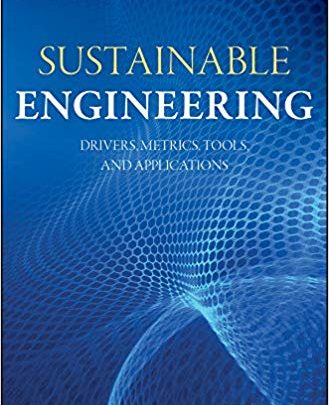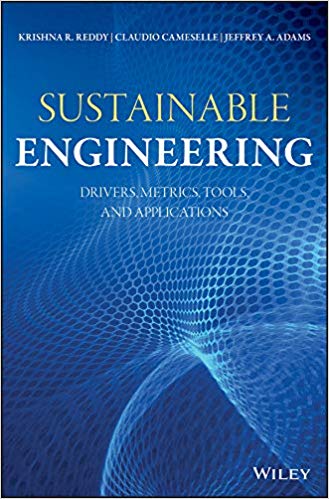دانلود کتاب Sustainable Engineering Drivers Metrics Tools Engineering Practices Applications

خرید ایبوک Sustainable Engineering Drivers Metrics Tools Engineering Practices Applications
برای دانلود کتاب Sustainable Engineering Drivers Metrics Tools Engineering Practices Applications بر روی کلید خرید در انتهای صفحه کلیک کنید. پس از اتصال به درگاه پرداخت و تکمیل مراحل خرید، لینک دانلود ایمیل می شود. این کتاب در قالب pdf اورجینال بلافاصله پس از واریز ارسال می شود.
در صورتی که نیاز به دانلود هر کتابی از آمازون یا گوگل بوک دارید، فقط کافیست ادرس اینترنتی کتاب را از سایت www.amazon.com و یا books.google.com برای ما ارسال کنید (راههای ارتباطی در صفحه تماس با گیگاپیپر ). پس از بررسی، هزینه ان اعلام می شود. پس از واریز نسخه الکترونیکی ارسال می شود.

Sustainable Engineering: Drivers, Metrics, Tools, and Applications 1st Edition, Kindle Edition
by Krishna R. Reddy (Author), Claudio Cameselle (Author), Jeffrey A. Adams (Author)
File Size: 70516 KB
Print Length: 544 pages
Publisher: Wiley; 1 edition (April 22, 2019)
Publication Date: April 22, 2019
Sold by: Amazon Digital Services LLC
Language: English
ASIN: B07R6B6LKX
https://public.ebookcentral.proquest.com/choice/publicfullrecord.aspx?p=5750073
https://www.worldcat.org/title/sustainable-engineering-drivers-metrics-tools-and-applications/oclc/1100974262/
For Download Please Contact Us :
Price : 25$
دانلود رایگان ایبوک Sustainable Engineering Drivers Metrics Tools Engineering Practices Applications
برای اطمینان از کیفیت کتاب ، چند صفحه ابتدایی ان بصورت رایگان قرار داده شده است.
درباره کتاب Sustainable Engineering Drivers Metrics Tools Engineering Practices Applications
Comprehensively covers the definition, methodology, and current applications of the principles of sustainability and resiliency in every engineering discipline
This book contains detailed information about sustainability and resiliency principles and applications in engineering practice, and provides information on how to use scientific tools for sustainability assessment that help engineers select the best alternative for each project or activity. Logically organized around the three pillars of sustainability—environment, economy, and society—it is a primary resource for students and professionals alike.
Sustainable Engineering: Drivers, Metrics, Tools, and Applications offers numerous ways to help engineers contribute towards global sustainable development while solving some of the grand challenges the world is facing today. The first part of the book covers the environmental, economic, and social impacts associated with project/product development as well as society as a whole. This is followed by a section devoted to sustainability metrics and assessment tools, which includes material flow analysis and material budget, carbon footprint analysis, life cycle assessment, environmental health risk assessment, and more. Next comes an in-depth examination of sustainable engineering practices, including sustainable energy engineering, sustainable waste management, and green and sustainable buildings. The book concludes with a look at how sustainable engineering may be applied to different engineering (i.e. environmental, chemical, civil, materials, infrastructure) projects.
Some of the key features of this book include the following:
Provides a complete and sensible understanding of the important concepts of sustainability, resiliency, and sustainable engineering
Offers detailed explanations of sustainable engineering practices in waste management and remediation of contaminated sites, civil construction and infrastructure, and climate geoengineering
Presents a set of case studies across different engineering disciplines such as bio/chemical, environmental, materials, construction, and infrastructure engineering that demonstrate the practical applicability of sustainability assessment tools to diverse projects
Includes questions at the end of each chapter as well as a solutions manual for academic adopters
The depth of coverage found in Sustainable Engineering: Drivers, Metrics, Tools, and Applications makes it an ideal textbook for graduate students across all engineering disciplines and a handy resource for active professionals
دانلود کتاب کاربردهای مهندسی پایدار درایورهای مهندسی متریک
تعریف ، روش و کاربردهای فعلی اصول پایداری و تاب آوری در هر رشته مهندسی را بطور کامل پوشش می دهد
این کتاب حاوی اطلاعات مفصلی در مورد اصول و کاربردها و کاربردهای پایداری و تاب آوری در تمرین مهندسی است و اطلاعاتی در مورد نحوه استفاده از ابزارهای علمی برای ارزیابی پایداری ارائه می دهد که به مهندسان کمک می کند تا بهترین گزینه را برای هر پروژه یا فعالیت انتخاب کنند. به طور منطقی در اطراف سه ستون پایداری – محیط ، اقتصاد و جامعه – سازماندهی شده است و منبع اصلی دانشجویان و متخصصان است.
مهندسی پایدار: درایورها ، اندازه گیری ها ، ابزارها و برنامه ها روشهای بی شماری را برای کمک به مهندسین جهت کمک به توسعه پایدار جهانی در حالی که برخی از چالش های بزرگ جهان امروز با آن روبرو هستند ارائه می دهد. بخش اول کتاب تأثیرات زیست محیطی ، اقتصادی و اجتماعی مرتبط با توسعه پروژه / محصول و همچنین کل جامعه را در بر می گیرد. این دنباله ای است که به معیارهای پایداری و ابزارهای ارزیابی اختصاص داده شده است ، که شامل تجزیه و تحلیل جریان مواد و بودجه مواد ، تجزیه و تحلیل رد پای کربن ، ارزیابی چرخه زندگی ، ارزیابی ریسک بهداشت محیط و موارد دیگر می باشد. در مرحله بعدی بررسی عمیق شیوه های مهندسی پایدار از جمله مهندسی انرژی پایدار ، مدیریت پسماند پایدار و ساختمانهای سبز و پایدار ارائه می شود. این کتاب با نگاهی به این نتیجه می رسد که چگونه می توان مهندسی پایدار را برای پروژه های مختلف مهندسی (یعنی محیط زیست ، شیمیایی ، عمران ، مواد ، زیرساخت ها) به کار برد.
برخی از ویژگی های مهم این کتاب شامل موارد زیر است:
درک کاملی و معقول از مفاهیم مهم پایداری ، تاب آوری و مهندسی پایدار را فراهم می کند
ارائه توضیحات مفصل در مورد روشهای مهندسی پایدار در مدیریت پسماند و ترمیم سایتهای آلوده ، ساخت و سازهای عمرانی و زیرساختها و مهندسی آب و هوا
مجموعه ای از مطالعات موردی را در رشته های مختلف مهندسی مانند زیست شیمیایی ، زیست محیطی ، مواد ، ساخت و ساز و مهندسی زیرساخت ارائه می دهد که کاربرد عملی ابزارهای ارزیابی پایداری در پروژه های متنوع را نشان می دهد.
شامل سوالات در پایان هر فصل و همچنین یک کتابچه راهنمای راه حل برای پذیرندگان دانشگاهی است
عمق پوشش یافت شده در مهندسی پایدار: درایورها ، اندازه گیری ها ، ابزارها و برنامه ها آن را به یک کتاب درسی ایده آل برای دانشجویان فارغ التحصیل در تمام رشته های مهندسی و یک منبع مفید برای متخصصان فعال تبدیل می کند.
فهرست مطالبSustainable Engineering Drivers Metrics Tools Engineering Practices Applications
Cover; Title Page; Copyright; Contents; Preface; Part I Drivers, Environmental, Economic and Social Impacts, and Resiliency; Chapter 1 Emerging Challenges, Sustainability, and Sustainable Engineering; 1.1 Introduction; 1.2 Emerging Challenges; 1.2.1 Increased Consumption and Depletion of Natural Resources; 1.2.1.1 Easter Island Example; 1.2.1.2 Metallic Ores Consumption Example; 1.2.2 Growing Environmental Pollution; 1.2.3 Increasing Population; 1.2.4 Increasing Waste Generation; 1.2.5 Increasing Greenhouse Gas Emissions; 1.2.6 Decline of Ecosystems; 1.2.7 Loss of Biodiversity 1.2.8 Social Injustice1.2.9 Urban Sprawl; 1.3 The Master Equation or IPAT Equation; 1.4 What Is Sustainability?; 1.5 What Is Sustainable Engineering?; 1.6 Summary; 1.7 Questions; References; Chapter 2 Environmental Concerns; 2.1 Introduction; 2.2 Global Warming and Climate Change; 2.3 Desertification; 2.4 Deforestation; 2.5 Loss of Habitat and Biodiversity; 2.6 Ozone Layer Depletion; 2.7 Air Pollution; 2.8 Smog; 2.9 Acid Rain; 2.10 Water Usage and Pollution; 2.11 Eutrophication; 2.12 Salinity; 2.13 Wastes and Disposal; 2.14 Land Contamination; 2.15 Visibility; 2.16 Odors 2.17 Aesthetic Degradation2.18 Land Use Patterns; 2.19 Thermal Pollution; 2.20 Noise Pollution; 2.21 Summary; 2.22 Questions; References; Chapter 3 Social, Economic, and Legal Issues; 3.1 Introduction; 3.2 Social Issues; 3.2.1 Society; 3.2.2 Developed and Developing Societies; 3.2.3 Social Sustainability Concept; 3.2.4 Social Indicators; 3.2.5 Social Impact Assessment; 3.2.6 Social Sustainability Implementation; 3.3 Economic Issues; 3.3.1 Economic Assessment Framework; 3.3.2 Life Cycle Costing; 3.3.3 True-cost Accounting; 3.4 Legal Issues; 3.5 Summary; 3.6 Questions; References Chapter 4 Availability and Depletion of Natural Resources4.1 Introduction; 4.2 Types and Availability of Resources; 4.2.1 Fossil Fuels; 4.2.2 Radioactive Fuels; 4.2.3 Mineral Resources; 4.2.4 Water Resources; 4.2.5 Other Elemental Cycles; 4.3 Resource Depletion; 4.3.1 Causes of Resource Depletion; 4.3.2 Effects of Resource Depletion; 4.3.3 Overshooting; 4.3.4 Urban Metabolism; 4.4 Summary; 4.5 Questions; References; Chapter 5 Disaster Resiliency; 5.1 Introduction; 5.2 Climate Change and Extreme Events; 5.3 Impacts of Extreme Events; 5.3.1 The 2012 Hurricane Sandy in New York City 5.3.2 The 2016 Chile’s Wildfires by Drought and Record Heat5.3.3 The 2017 Worst South Asian Monsoon Floods; 5.4 What Is Resiliency?; 5.5 Initiatives and Policies on Resiliency; 5.6 Resiliency Framework; 5.7 Resilient Infrastructure; 5.8 Resilient Infrastructure Examples; 5.8.1 San Francisco Firehouse Resilient Design; 5.8.2 San Francisco Resilient CSD Design; 5.8.3 Resilient Environmental Remediation; 5.9 Challenges; 5.10 Summary; 5.11 Questions; References; Part II Sustainability Metrics and Assessment Tools; Chapter 6 Sustainability Indicators, Metrics, and Assessment Tools